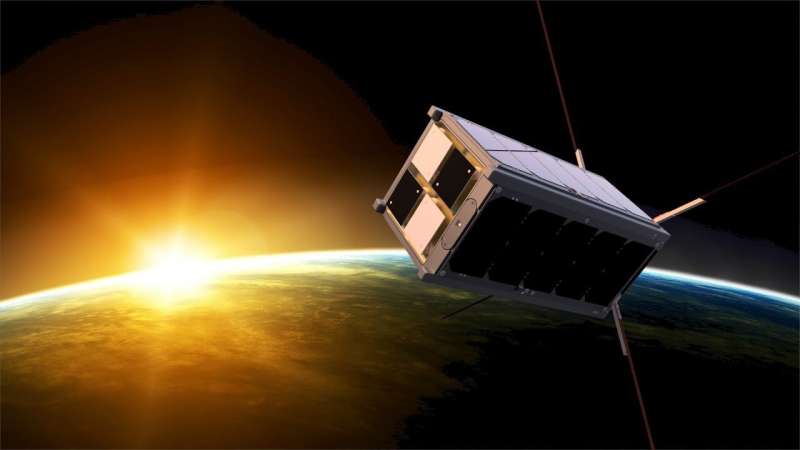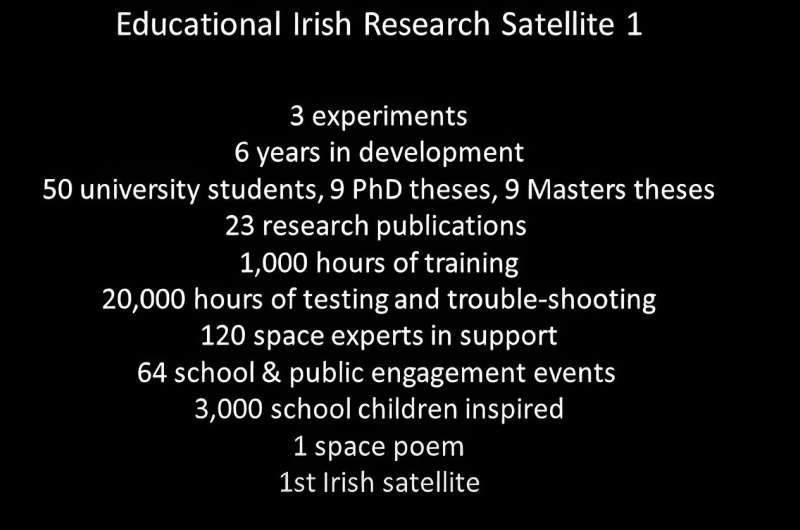This article has been reviewed according to Science X's editorial process and policies. Editors have highlighted the following attributes while ensuring the content's credibility:
fact-checked
trusted source
proofread
Lift-off for EIRSAT-1, Ireland's first ever satellite

Six years of hard work and dedication paid off in spectacular fashion on Dec. 1 as the Educational Irish Research Satellite, EIRSAT-1, successfully blasted off from Vandenberg Space Force Base, California. Hitching a ride on a Space-X Falcon-9 launcher, the tiny satellite—measuring just 10.7cm x 10.7cm x 22.7cm—has now made history as Ireland's first satellite.
EIRSAT-1 was designed, built, and tested by students from University College Dublin (UCD) participating in ESA Academy's Fly Your Satellite! program, a hands-on initiative supporting university student teams to develop their own satellites according to professional standards. The launch opportunity itself was provided by ESA.
ESA experts have been on-hand throughout the satellite's development to offer training and guidance to dozens of UCD students. Their learning journey also included test campaigns at ESA Education's CubeSat Support Facility in Belgium, and dedicated spacecraft communications sessions both at ESA Academy's Training and Learning Center and at the European Space Operations Center in Darmstadt Germany, to learn Ireland's first spacecraft operations procedures.
"I would like to wholeheartedly congratulate the EIRSAT-1 team for this successful launch and the start of Ireland's first exciting adventure in orbit," said Josef Aschbacher, ESA Director General. I'd also like to thank UCD for joining forces with ESA towards a common educational objective: boosting the skills of the young generation," he continued.
"It's only by building capacity that we can make our space ambitions become a reality, for Ireland and for Europe. With our Education program we are nurturing generations of citizens who are learning to use space technology and space solutions in order to make a difference for our society, our planet and our future."
From low Earth orbit EIRSAT-1 will carry out three main experiments, which were built from scratch by the students:
- GMOD, a detector to study gamma ray bursts, which are the most luminous explosions in the universe and occur when a massive star dies or two stars collide.
- EMOD, an experiment to see how a thermal treatment protects the surface of a satellite when in space.
- WBC, an experiment to test a new method of using Earth's magnetic field to change a satellite's orientation in space.

Following EIRSAT-1's deployment to orbit, the student team is now working to establish contact with the satellite and start operations from their dedicated ground control facility, also entirely operated by students and located at UCD in Dublin.
"The team at ESA Education would like to join ESA DG in expressing their heartfelt congratulations to the EIRSAT-1 students for achieving their incredible goals," said Hugo Marée, Head of the ESA Education Office.
"Not only has EIRSAT-1 made history by being Ireland's first satellite, but it has also inspired a generation of Irish school students to grow their ambitions higher. This has been achieved thanks to the inspirational activities organized by ESERO Ireland (a collaboration between ESA and Science Foundation Ireland) around this mission," he continued. "I am proud of our Education program which is able to inspire and engage different age groups towards a future career in STEM."
Provided by European Space Agency




















